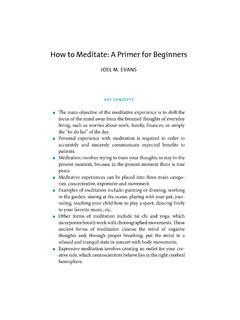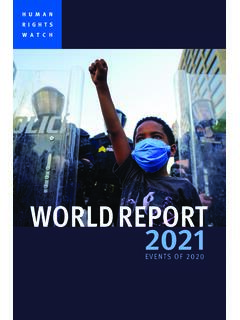Transcription of CULTURAL DIVERSITY IN CANADA: The Social Construction of ...
1 CULTURAL DIVERSITY IN CANADA: The Social Construction of RacialDifferencesPeter S. LiProfessor of SociologyUniversity of SaskatchewanResearch andStatistics Division2000 SERVING CANADIANSSTRATEGIC ISSUES SERIESrp02-8eRESEARCH PAPER: CULTURAL DIVERSITY IN CANADA: THE Social Construction OF RACIAL DIFFERENCESThe views in this discussion paper are those of the authorand do not represent the views or positions of theDepartment of Justice, Canada. The paper wascommissioned as an opinion piece to stimulate research and Statistics Division iiiStrategic Issues SeriesThe Research Papers included in the Strategic Issues series generally have beenprepared for the Statistics and Environmental Analysis Unit of the Research andStatistics Division (RSD). This series is part of the Research and Statistics Division sefforts to look ahead and to scan the environment to provide contextual facts andperspectives on a wide range of Social and economic issues. Topics covered include:the policy challenges of bio-technology and genetics; speculation on markets forcrime and a proposed typology for understanding crime; the impacts on children ofdivorce and separation; globalization; and global governance of the Internet.
2 The papers that will be included are thought-provoking. In general they have beenwritten by academics whose commission instructed them to be wide-ranging in theircritique of current practices and provocative in their suggestions for new approaches. Discussion papers and think pieces in this section of the RSD library have alreadystimulated discussion for exercises such as: new mandate planning, strategic policyplanning by senior executives or as backgrounders for research planning. It is ourintention to offer them here so that they now can contribute to wider discussionamong researchers and policy-makers. For further information, please contactValerie Howe, Senior Research OfficerTelephone: (613) 957-9597, E-mail: S. Li is a professor of Sociology at the University of Saskatchewan and Chair ofthe Economic Domain at the Prairie Centre of Excellence for Research onImmigration and Integration. He has served as associate editor of the CanadianReview of Sociology and Anthropologyand is currently the associate editor of Journalof Comparative Family Studies.
3 He has also served as consultant to several federaldepartments with regards to policies of immigration, multiculturalism and racerelations. Among his books are Race and Ethnic Relations in Canada(Oxford, 1999), TheChinese in Canada(Oxford, 1988, 1998), The Making of Post-War Canada(Oxford,1996), Racial Oppression in Canada(Garamond, 1988), and Ethnic Inequality in aClass Society(Thompson, 1988).Research and Statistics Division public discourse has used the term CULTURAL DIVERSITY to refer to the apparentgrowth of non-white population, other than the aboriginal people, in Canadian the popularity of the term DIVERSITY is a rising public awareness towardsdifferences of people, which may be imagined or real, based on superficial distinctionssuch as skin colour and other features. The sensitivity towards racial differences haspartly to do with a widely held belief that immigration since the late 1960s has alteredthe CULTURAL mix of Canadians, and that the increase in DIVERSITY has caused, amongother things, tensions and adjustments in Canadian society.
4 Such a popular view is notentirely groundless, although many features are distorted or exaggerated. The purposeof this paper is to clarify the facts of DIVERSITY and to explain how racial differences inCanadian society have been produced and constructed, with the view of shedding lighton policy options for the CULTURAL DIVERSITY in CanadaCanada's demographic composition is ethnically heterogeneous, in the sense that itscitizens have come from many countries of origin and CULTURAL backgrounds. Onecustomary way to depict CULTURAL DIVERSITY in Canada is describe it in terms of thepopulation size of those not belonging to the two charter groups. Indeed, this was themethod adopted by the Royal Commission on Bilingualism and Biculturalismin the1960s, which coined the term the Third Force to refer to Canadians not of British andFrench origin (Canada, Royal Commission on Bilingualism and Biculturalism, 1965:52).1In its final report, the Royal Commission stressed that Canada was a mosaic, or amulticultural society, made up of three basic elements: the British, the French, andother Canadians.
5 While recognizing the charter status of the British and the French,the Royal Commission also acknowledged the contributions of other non-chartergroups. This trichotomy has been essentially adopted as the proper way to discuss thenature and composition of Canada's population DIVERSITY . Historically, the numeric predominance of those of British and French origin wasunquestionable. Before the great wave of European migration to Canada between 1896and the beginning of the First World War, Canada's population was indeed mainlymade up of those of British and French origin. For example, the 1871 Census ofCanada shows that 60 percent of Canada's million people were of British origin,1 The Royal Commission wrote a five-volume report, the first was published in 1967, and the last one in 1970 (Canada, Royal Commission on Bilingualism and Biculturalism,1967, 1968, 1969a, 1969b, 1970). Throughout the report, the framework used was a trichotomy composed of theBritish, the French and other Canadians, which paid little attention to the First Nations as people with distinct aboriginal rights and PAPER: CULTURAL DIVERSITY IN CANADA: THE Social Construction OF RACIAL DIFFERENCES2 Research and Statistics Divisionand 30 percent French origin; Europeans not of British nor French origin accounted foronly 7 percent of Canada's population in 1871 as well as in 1881 (Kalbach, 1990: 24).
6 This demographic composition basically persisted until the turn of the wave of immigration to Canada prior to the First World War began to increase thestock of Europeans not from British or French origin. Between 1896 and 1914, overthree million immigrants came to Canada. When the supply of emigrants from Englandand Western Europe was dwindling, Canada began accepting people from Eastern andSouthern Europe, including Poles, Ukrainians, Hutterites and Doukhobors. In theperiod between the two world wars from 1915 to 1945, another two million immigrantscame to Canada (Statistics Canada, 1983: A125-163).The census data of Canada indicate that Canadians of European origin other thanBritish and French increased from percent of the total population in 1901 to in 1921, and to percent in 1941 (Kalbach, 1990: 24). In contrast, Canadiansof British origin declined in relative terms from 57 percent of the total population in1901 to 50 percent in 1941, but those of French origin remained at around 30 percent ofthe total population in 1901 and in 1941.
7 In short, if the composition of Canadians ofEuropean origin other than British and French is used as an indicator of ethnicplurality, then there was an increase in DIVERSITY between 1901 and 1941. However,Canada's population in 1941, as in 1871, was made up of people mainly of Europeanorigin, which accounted for 98 percent of the total population in 1941 and in 1871,despite the fact that the population had increased from million people in 1871 million people in 1941. 1921 1931 1941 1951 1961 1971 Origin % % % % % % British French Other European 23 Asian Aboriginal Black Other Total Per Cent 100 100 100 100 100 100 Total Number 8,787,949 10,376,786 11,506,655 14,009,429 18,238,247 21,568,310 Table 1: Population by Ethnic Origin, Canada, 1921-1971 Source:Compiled from Census of Canada, 1971, Polulation: Ethnic Groups, Catalogue 92-723, Volume 1, Part 3, Bulletin , Table and Statistics Division 3 Between 1941 and 1961, the proportion of Canadians of European origin other thanBritish and French further increased; in 1941, they made up percent of the totalCanadian population, by 1961, they rose to percent (Table 1).
8 In contrast, those ofBritish origin declined in relative terms from percent in 1941 to percent in1961. Thus, the expansion in ethnic DIVERSITY between 1941 to 1961 was also in thedirection of increasing the proportion of Canadians of European origin other thanBritish and French, and decreasing the proportion of Canadians of British , the ethnic composition of the Canadian population continued to beoverwhelmingly those of European origin, which remained at 97 percent of the totalpopulation in 1961 and 96 percent in 1971. Thus, when the Royal Commission onBilingualism and Biculturalism wrote about the Third Force and its place in theCanadian mosaic, it was writing from the vantage point of a multicultural Canadamade up of mostly those of British, French and other European Immigration Pattern and the Emergence of VisibleMinorities Historically, Canada had relied upon Western Europe, in particular Great Britain, as themajor supplier of immigrants to Canada.
9 In the two decades after the end of theSecond World War, Canada maintained its policy of favouring immigrants from theUnited States, United Kingdom and other European countries. However, in the 1960s,there were major changes in the Canadian immigration policy which placed moreemphasis on educational and occupational skills as criteria for selecting immigrants,although sponsored immigrants under family unification and refugee settlementremained important components of in immigration regulations in 1967 resulted in the adoption of a universalpoint system in assessing prospective immigrants, irrespective of country of origin orracial background ( 1967-1616). The 1967 immigration regulations reflectedCanada's attempt to compete for skilled labour around the world, although otherfactors were also influencing the change of policy (Li, 1992a).The impact of the 1967 immigration regulations can be seen from immigrationstatistics (Li, 1992a: 153-157). Between 1954 and 1967, Canada lost 60,230 people inprofessional, technical, managerial, and entrepreneurial occupations to the UnitedStates.
10 In return, Canada received 33,119 immigrants in these occupations from theUnited States. A consequence of the 1967 immigration regulations was to reverse thistrend, as Canada placed more emphasis on human capital as the basis of immigrantselection. For the eighteen year period between 1968 and 1986, Canada experienced anet gain of 16,349 immigrants in professional, technical, managerial andentrepreneurial occupations from the United States (Li, 1992a). RESEARCH PAPER: CULTURAL DIVERSITY IN CANADA: THE Social Construction OF RACIAL DIFFERENCES4 Research and Statistics DivisionAlthough European immigrants to Canada made up the majority of immigration toCanada in the post-war period, their importance, in terms of the proportion of thetotal immigrants admitted, declined after 1967. In the 1940s and 1950s, immigrationto Canada was made up almost exclusively of immigrants from Europe. For example,in the post-war years from 1946 to 1953, Canada admitted slightly less than 1 millionimmigrants into Canada, about 96 percent of whom came from Europe; Britishimmigrants alone accounted for 35 percent of this stream of immigration (StatisticsCanada, 1965).






